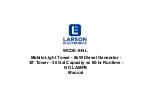
9
2
2
2
2
2
1
1
1
1
1
IS 2500 generators are equipped with two pole
synchronous brushless alternators. These alter-
nators are also self-regulating and self-exciting
with capacitor (Fig. 1 Ref. 5) connected to the
auxiliary winding of the stator (Fig. 1 Ref. 3).
The alternators generate an alternating voltage
at the terminals of the main winding (Fig. 1Ref.
4) having a frequency of 50 or 60 Hz. (Depend-
ing on whether the engine runs at 3000 or 3600
R.P.M.).
The generation of current is in accordance with
the principle described here below:
On starting the unit, the magnetic force of the
rotor (residual magnetism of the nucleus) in-
duces a voltage in the auxiliary winding of
excitation (Fig. 1 Ref. 3). This voltage is fed to
the capacitor (Fig. 1 Ref. 5) which creates a
capacitive current circulating in the closed cir-
cuit constituted of the capacitor and the auxil-
iary winding.
This capacitive current, creates a magnetic field
reinforcing the magnetism of the rotor, thus
creating in it a voltage which rectified by the
diodes (Fig. 1 Ref. 2) makes a D.C. current
circulate in the induction windings (Fig. 1 Ref.
1). As a result of which a rotating magnetic field
is created which generates the rated output in
the principal winding (Fig. 1 Ref. 4) and which
can be tapped at the terminals.
The voltage and current values (denoted in
percentage terms of rated values are as shown in
the diagram (Fig. 2).
As you will note, it is possible to get energy up
to the nominal value. With voltage practically
constant (+/- 5%). Moreover, the alternator at
a voltage not inferior to 70-75% of the rated
voltage, is able to furnish, as initial power rush,
up to 3 times the rated amperage.
As we know, this initial rush, typical of this
alternator is extremely important to start asyn-
chronous motors.
I generatori della serie IS 2500 sono dotati di
alternatori senza spazzole, sincroni, a due poli,
autoregolati, autoeccitati, con condensatore
(Fig. 1 Rif. 5) collegato con l'avvolgimento
ausiliario di statore (Fig. 1 Rif. 3). Gli alterna-
tori generano una tensione alternata, disponibi-
le ai morsetti dell'avvolgimento principale (Fig.
1 Rif. 4) a una frequenza di 50/60 Hz. (Corri-
spondenti ad una velocità del motore primo di
3000/3600 giri) secondo il principio di seguito
descritto.
All'avviamento il magnetismo di rotore (ma-
gnetismo residuo del nucleo) induce nell'avvol-
gimento ausiliario di eccitazione (Fig. 1 Rif. 3)
una tensione.
Questa tensione è applicata al condensatore
(Fig. 1 Rif. 5) e fa circolare nel circuito chiuso,
costituito dal condensatore e dall'avvolgimento
ausiliario, una corrente capacitiva.
Questa corrente produce un campo magnetico
che rafforza il magnetismo di rotore, generando
in esso una tensione che, raddrizzata dai diodi,
(Fig. 1 Rif. 2) fa circolare una corrente continua
negli avvolgimenti induttori (Fig. 1 Rif. 1).
Il campo magnetico rotante dovuto alla circola-
zione di questa corrente genera a sua volta
nell'avvolgimento principale (Fig. 1 Rif. 4) la
tensione nominale ai morsetti del generatore.
I valori (intesi come percentuale dei valori
nominali) di tensione e corrente disponibili ai
morsetti hanno l'andamento riportato nel dia-
gramma (Fig. 2). Come si può notare è possibile
prelevare corrente fino al valore nominale a
tensione praticamente costante (+/- 5%). Ed
inoltre l'alternatore, ad una tensione non infe-
riore al 70-75% del valore nominale, è ancora in
grado di fornire una corrente di picco pari a
circa 3 volte il valore nominale.
Questa caratteristica, tipica di questo alternato-
re è particolarmente utile nella fase di avvia-
mento dei motori elettrici asincroni.
3) PRINCIPLE OF POWER
3) PRINCIPLE OF POWER
3) PRINCIPLE OF POWER
3) PRINCIPLE OF POWER
3) PRINCIPLE OF POWER
GENERATION
GENERATION
GENERATION
GENERATION
GENERATION
1) PRINCIPIO DI FUNZIONAMENTO
1) PRINCIPIO DI FUNZIONAMENTO
1) PRINCIPIO DI FUNZIONAMENTO
1) PRINCIPIO DI FUNZIONAMENTO
1) PRINCIPIO DI FUNZIONAMENTO
Содержание IS 2500
Страница 2: ...2...










































